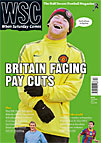 Howard Pattison goes in search of football heritage and asks why more blue plaques aren’t awarded to players
Howard Pattison goes in search of football heritage and asks why more blue plaques aren’t awarded to players
In 1999 the writer Hunter Davies asked: “Why are there no blue plaques for footballers?” Over a decade on, they are still so rare that you begin to wonder if those who administer our heritage simply don’t see football as being part of it. Surely Bobby Moore is worthy of a blue plaque?
Yet if you consult English Heritage’s directory you will find George Moore, author (1852-1933), and Henry Moore, sculptor (1898-1986), but not a mention of Bobby. Bill Nicholson is listed, but only in the guise of Sir William Nicholson, painter and printmaker (1872-1949). A journalist, author and topographer called Arthur Mee (1875-1943) is deserving of recognition, but he is not followed by Bertie. It’s with considerable relief that you finally locate Herbert Chapman in Hendon.
The absentees are excused by the rules of English Heritage. Not only must dedicatees be associated with a London property, they must also have been deceased for 20 years (or a century should have passed since their birth). These disqualifications suggest that football is still a relatively new social phenomenon; many of its protagonists simply haven’t been long enough in the ground to be recognised. And those that are long dead are often not associated with the capital. The early development of the national game lies in the provinces, where it is invisible to the English Heritage scheme.
Fortunately there are often local, more relaxed arrangements to catch these out-of-towners. The lack of a national organisation, though, means that the schemes run by councils or civic groups can make for unpredictable results. No footballers have ever come from Birmingham and nothing at all seems to have happened in Sheffield. Manchester, on the other hand, seems quite pleased with itself. The original home addresses of City and United are marked with plaques (both of them red), as is the site where the Football League first declared its name. But there’s still no sign of any individual players or managers, no mention of any place where Matt Busby rested his head or Billy Meredith laid his toothpick.
Busby emerged into the world at Orbiston, Bellshill, but North Lanarkshire council has not registered this, whereas the local authority in Rhondda has gleefully jumped on the fact that Jimmy Murphy, Busby’s assistant at Old Trafford, was a local boy. Similar enthusiasm has resulted in a plaque to mark Billy Wright’s birthplace in Ironbridge, which would otherwise have no historical significance at all, and while the Spen Valley Civic Society doesn’t have a plaque for Stanley Matthews, it’s not so ashamed that it won’t recognise the firm that made his boots.
There is nothing outside my local pub to mark the fact that it was once run by former Arsenal and England forward Cliff Bastin. I dare say that there are pubs the length and breadth of the country that could bear witness to the ex-footballer that once lived there; it used to be the profession of choice once the playing career had ended. Indeed, a national blue plaque scheme for footballers could easily become a useful social document. Jack Dyson, for instance, scored in the 1956 FA Cup final and also played cricket for Lancashire. When it was all over he became a milkman and ended his days in an Oldham council house. A blue plaque on the estate would provide quite a contrast to the one you’d slap on the Cheshire mansions where the likes of Robinho now pass through.
Of course there isn’t anything to stop you screwing a plaque to your own wall if you so wish. There are statues and memorials that decorate the exteriors of many of our football stadiums, and it’s here that you’ll find a dedication to Bobby Moore that is not bound by the strictures of English Heritage. This was arranged by a charitable body called the Heritage Foundation, which clearly sees our sporting history as belonging to the same world as popular music and light entertainment, but their awards list still suggests that football is not seen as having made a contribution to society as vital as that made by Terry Scott and Hattie Jacques. Is it any wonder that English Heritage can’t be bothered to put Johnny Haynes’s name up in the same city as Sir Christopher Wren?
It looks as though it’s the fans’ responsibility to honour these names; we must either harangue local councils or make our own arrangements. In London you can at least accept English Heritage’s invitation to propose a recipient, but you should beware those rules. The 20th anniversary of Bobby Moore’s death falls in 2013. Only then, it seems, will we find out if football really is regarded as part of England’s heritage.
From WSC 286 December 2010